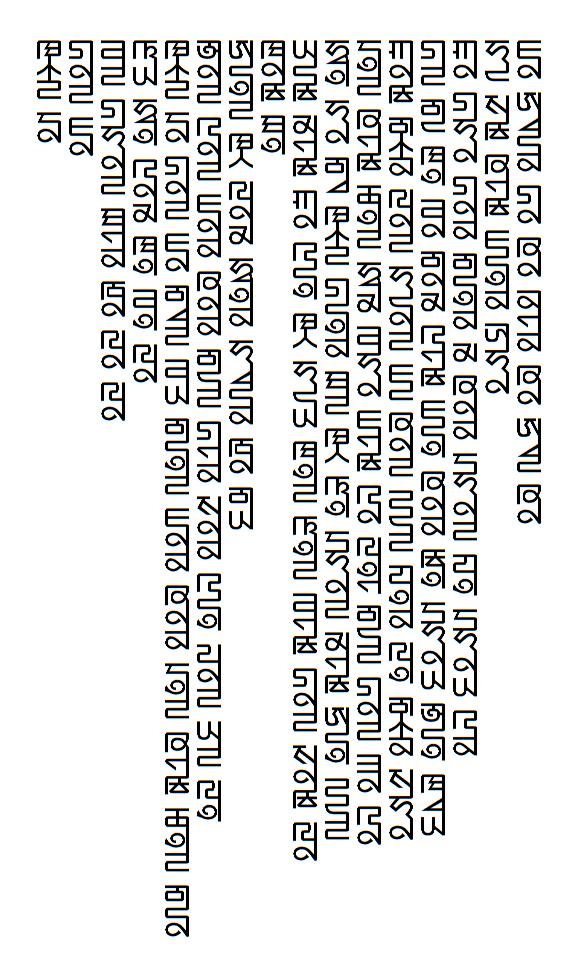Hmm...okay, maybe I should get the ball rolling.
So, couple of things out of the way:
1.
We need a name for this. DF Dwarves don't have a word for "dwarf", but then they wouldn't see themselves as dwarves. So I think we can assume they would use the word
udos, "man" for themselves. Many language names (especially primitive ones) translate roughly as "speech/tongue of the people/humans/men". "Speak" is
âm, which doesn't render easily because of the extended character. "Tongue", however, is a simple
nol, which would give us
Udosnol, or "man-tongue". Works for me.
2.
What kind of system is a best fit?We have five basic categories to start with:
A.
Alphabetic -- The kind most of us are familiar with, one glyph per sound. Means we'll have about 20-35 glyphs in total.
B.
Syllabary -- Uses one glyph per CV (consonant-vowel) unit, with some final consonants as well. Best known example is hiragana/katakana in Japanese and Inuktitut.
C.
Abjad -- Consonants only, vowels are not specifically indicated, or are indicated using other consonants or diacritic marks. Typically found associated with Semitic languages where a three-consonant "root" forms the basis for a cluster of related words. Best examples: Arabic, Hebrew.
D.
Abugida -- Sort of a hybrid of the syllabary and abjad. The basic unit of writing is the syllable, but most glyphs are a consonant plus a default vowel (typically "-a"). Changes to other vowels are indicated by diacritic marks. Best examples: Virtually all the writing systems of the Indian subcontinent
E.
Ideographic -- Many words have pictographic glyphs, although those glyphs can become phonetic markers as well for use in imported words or abstract words for which there are no good pictograms. Best examples: Chinese, Egyptian hieroglyphs
At first glance, I thought Udosnol would absolutely need an alphabet, because it doesn't seem all that CVCVC(V) at a glance. But then I actually started looking through the wordlist, and it actually is pretty amenable to a syllabic system, as long as you have plenty of accomodation for final consonants, and maybe treat consonant clusters like
st as their own phoneme.
Examples:
urist (dagger) - VCVC(C)
libash (axe) - CVCVC(C)
tosid (armor) - CVCVC
kogan (boat) - CVCVC
cog (boot) - CVC
rakust (tomb) - CVCVC(C)
dastot (sword) - CVC(C)VC
So now I'm kinda jazzed about the idea of doing something along the lines of an abjad or abugida, especially because of the next consideration:
3.
What should it *look* like?There's a basic principle in human writing systems -- if you're writing on something hard with basic tools, you want a script with lots of simple geometric shapes and straight lines. When you make that leap to paper and/or paint/ink, it encourages curves and whatnot. I would assume Udosnol, being used mostly for engraving, would be a runic-type language. But then, these are dwarves. So carving on rocks comes naturally to them, and they might be able to handle curvilinear engraving with basic tools. They also might be prone to making things incredibly more complicated than they need to be.

With the above consideration of using an abjad/abugida, I like the idea of a script where characters in a single word could be physically linked, so that you could denote word seperation by a small break in the continuous line. For example (in Devanagari):

(using images rather than text, just because a lot of people may not have character support installed for some of these)
Another idea is that it doesn't have to go horizontally. For example, 'Phags-pa (now extinct) was a vertical abugida script created as an attempt to make a common script for the Yuan Dynasty in China (i.e. Kublai Khan and his Mongol followers) and their Chinese subjects. It eventually died out as most of the Yuan nobility eventually forgot Mongolian and learned only Chinese anyways. But it's a good stylistic inspiration:


 Author
Topic: DF Dwarven Script -- Udosnol (Read 13898 times)
Author
Topic: DF Dwarven Script -- Udosnol (Read 13898 times)
